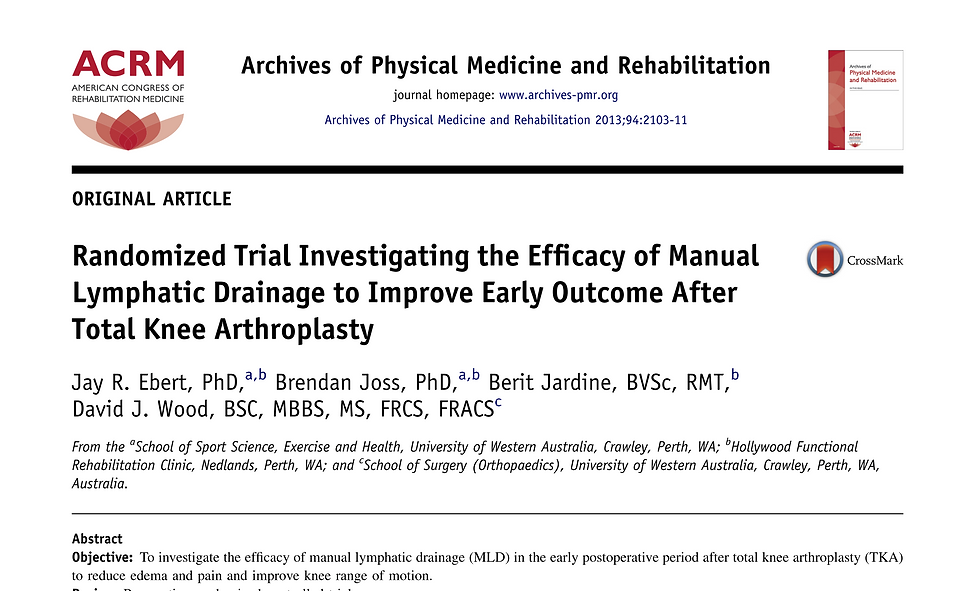MLD and total knee replacement
- Jan 9, 2021
- 3 min read
Updated: Feb 7
Next week my Mum will have a knee replacement. Scans show almost no cartilage left between the condyles and the tibial plateau, and the meniscus is severely disintegrated. Unfortunately her surgery is scheduled for when I am interstate teaching classes, but I have two very capable MLD therapists lined up to give her pre-and post-surgical MLD.
I already know how much MLD will benefit my Mum as she recovers from the surgery, both from my understanding of the physiological effects of MLD, and from the many other clients I have treated after their total knee replacements (TKR). My Mum will have the advantage of receiving MLD even before her surgery, but most of the clients I have treated over the years have come to me after around 6-months, when their post surgical rehab should be nearing its end, and life returning to normal.
my clients had experienced the expected course of healing during their rehabilitation, I probably would not have seen them in my clinic. Almost everyone I treated after TKR had experienced a poor surgical outcome, with significant swelling, pain and limited range of movement long after all these issues should have resolved. A short course of MLD usually got things back on track.
But you don't have to take my word for it. Research conducted at the University of Western Australia (1), with MLD applied by an accredited Dr Vodder therapist showed that participants had
"significantly greater active knee flexion in the MLD group when compared with the control (no MLD) group.. ..prior to hospital discharge.. ..and at 6 weeks post-surgery"(1).
There were small but still significantly better results in pain, activities of daily living, involvement in sports and recreation, and overall quality of life in the MLD group.
My Mum will also benefit from the application of lymph tapes which will continue to act like having continuous MLD, and scar tapes reduce adhesions and keep her scars flat and pale.
Photos of her progress will be posted to the Moving Lymph Facebook page
Ebert, J. R., Joss, B., Jardine, B., & Wood, D. J. (2013). Randomized Trial Investigating the Efficacy of Manual Lymphatic Drainage to Improve Early Outcome After Total Knee Arthroplasty. Archives of Physical Medicine and Rehabilitation, 94(11), 2103-2111.
Full text available doi:https://doi.org/10.1016/j.apmr.2013.06.009
Abstract
Objective: To investigate the efficacy of manual lymphatic drainage (MLD) in the early postoperative period after total knee arthroplasty (TKA) to reduce edema and pain and improve knee range of motion. Design: Prospective randomized controlled trial. Setting: Private hospital and functional rehabilitation clinic. Participants: Consecutive sample of patients (NZ43; 53 knees) scheduled for TKA. Intervention: MLD (vs no MLD) on days 2, 3, and 4 postoperatively. Both groups underwent conventional, concomitant physical therapy. Main Outcome Measures: Clinical assessment was undertaken pre- and postoperatively prior to and after the designated postoperative MLD sessions (days 2, 3, and 4) and at 6 weeks post surgery. This included active knee flexion and extension range of motion, lower limb girths (ankle, mid-patella, thigh, and calf), and knee pain using a numeric rating scale and the Knee Injury and Osteoarthritis Outcome Score. Results: A significant group effect was observed for active knee flexion, with post hoc tests demonstrating a significantly greater active knee flexion in the MLD group when compared with the control (no MLD) group at the final measure prior to hospital discharge (day 4 post surgery) and at 6 weeks post surgery. There were no further group effects observed for the remaining patient-reported and functional outcomes. Conclusions: MLD in the early postoperative stages after TKA appears to improve active knee flexion up to 6 weeks post surgery, in addition to conventional care.
.png)






Comments